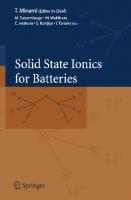Graphene for batteries
304 104 2MB
English Pages 2
Recommend Papers

- Author / Uploaded
- Daniel Cíntora Juárez
- Álvaro Doñoro Pina
- Vinodkumar Etacheri
File loading please wait...
Citation preview
See discussions, stats, and author profiles for this publication at: https://www.researchgate.net/publication/343046340
Graphene Based Electrodes for Rechargable Batteries Poster · May 2017
CITATIONS
READS
0
23
3 authors: Daniel Cíntora Juárez
Álvaro Doñoro
Self employed | Madrid Area
Madrid Institute for Advanced Studies
13 PUBLICATIONS 167 CITATIONS
3 PUBLICATIONS 4 CITATIONS
SEE PROFILE
SEE PROFILE
Vinodkumar Etacheri Madrid Institute for Advanced Studies 55 PUBLICATIONS 7,376 CITATIONS SEE PROFILE
Some of the authors of this publication are also working on these related projects:
(NAMBAT) Quest for safe and sustainable batteries using Na-ion, Mg and hybrid concepts View project
All content following this page was uploaded by Álvaro Doñoro on 18 July 2020. The user has requested enhancement of the downloaded file.
Graphene Based Electrodes for Rechargable Batteries Daniel Cíntora; Álvaro Doñoro; Vinodkumar Etacheri* Electrochemistry Group, IMDEA Materials Institute, C/ Eric Kandel 2, Getafe, Madrid 28906, Spain [email protected]
introduction
Graphene’s two dimensional structure gives rise to its exceptional properties,[1] which added to its low weight and large electrochemically active surface area, make graphene a highly interesting material for rechargable lithium battery (RLB) electrodes.[2, 3] However, the high irreversible capacity loss and the poor cycling stability of batteries, due to the extreme reactivity of single layer graphene with the electrolyte solution, has limited their commercialization. Herein, we have demonstrated the integration of multilayered graphene nanoplatelets in Liion battery anodes and Li-S / Li-O2 battery cathodes. These electrodes demonstrated excellent electrochemical DOI: 10.1039/C3TA13033A
performance as compared to the commercial electrodes and to various carbonaceous materials reported earlier.
Lithium - ion
Li Li Li Li Li Li Li Li Li Li Li Li
Li+
Li+
Li+
Li+
Li+
Li+ Li+
Li+ Li+ Li+
Li+ Li+
Li+
Li+ Li+
Li+ Li+
Li+
Li+
Li+
Li+
Li+
Organic electrolyte
0.0 800
-1 25 mA/g
800
50 mA/g
0.1 A/g
25 mA/g 0.2 A/g 0.5 A/g
600
1 A/g
400 200 0
0
10
20
30
40
Cycle number
-1
Capacity (mAh g )
Li+
Li+
S S S S
C
S S S S S S S S
Polysulfide dissolution, shuttle effect
S S S S S S S S
S
S S S S
Li+ Li+
1000
900 600 300 0 0
25
50 75 Cycle number
100
100
Graphene-based Li - ion
Graphene-based Li - S EV goal PHEV goal
NiMH HEV goal
10
Lead Acid Capacitors
1
101
102
103
104 -1
Specific Power (W kg )
Fig. 4: (a) Cycling performance of graphene nanoplatelet based Li-S system and (b) relative performance of two graphene-based batteries as compared to other energy storage systems.
(b)
(c)
(d) (e)
DOI: 10.1002/adma.201403064
Fig. 5: (a) Comparative of Li-O2 battery vs. other systems,[4] (b) drawbacks of Li-O2 battery, (c) scheme (d) electrochemical performance and e) image of Li-O2 coin cell [1] Geim, A. K.; Novoselov, K. S. Nat. Mater. 2007, 6, 183−191 [2] V. Etacheri , J. E. Yourey , B. M. Bartlett , ACS Nano 2014 , 8 , 14911499 [3] Wu, F; Lee, J. T; Zhao, E. Zhang, B; Yushin, G. ACS Nano 2016 , 8 , 1491-1499 [4] Bruce, P. G; Freunberger, S. A; Hardwick, L. J; Tarascon, J. M; Nat. Mater. 2012, 11, 19-29
View publication stats
CONCLUSIONS
REFERENCES
Lithium - oxygen
Fig. 2: (a) Second discharge profiles and (b) galvanostatic rate performance of commercial graphite and graphene nanoplatelets at a current density of 25 mA g-1. (a)
Li Li Li Li Li Li Li Li Li Li Li Li
200 mA/g
Capacity (mAh g )
0.5 600
5 m graphene platelets 25 m graphene platelets Graphite MCMB
1200
Capacity (mAh g )
-1
Potential (V vs. Li+/Li)
1.0
400
Li Li Li Li Li Li Li Li Li Li Li Li
1200
1000
2.5
200
Li Li Li Li Li Li Li Li Li Li Li Li
(b)
+
Fig. 3: (a) Scheme of a Li-S battery containing Li-metal anode and graphene nanoplatelet-sulfur hybrid cathode. (b) TEM image of graphene nanoplatelet-sulfur active material. (a) (b)
1400
25 m graphene platelets 5 m graphene platelets Graphite MCMB
0
A
Organic electrolyte
Fig. 1: (a) Scheme of a Li-ion full-cell containing graphene nanoplatelet anode and LiFePO4 cathode. (b) SEM image of 5µm graphene nanoplatelets. (a) (b) 3.0
e−
−
(a)
(b)
+
Charge
Specific Energy (Wh kg )
−
e−
Discharge
-1
A
Separator
(a)
Charge
e−
Separator
Discharge
e−
Lithium - Sulfur
1. Multilayered graphene nanoplatelets are successfully integrated in Li-ion, Li-S and Li-O2 battery systems. 2. These 2D-type electrodes demonstrated superior electrochemical performances compared to the current generation of carbonaceous electrodes. 3. Further performance enhancements and optimizations of rechargeable batteries containing graphene nanoplatelets are in progress.

![Advanced Technologies for Rechargeable Batteries. Volume 2: Metal Ion, Hybrid, and Metal-Air Batteries [2]
9781032315362](https://ebin.pub/img/200x200/advanced-technologies-for-rechargeable-batteries-volume-2-metal-ion-hybrid-and-metal-air-batteries-2-9781032315362.jpg)






